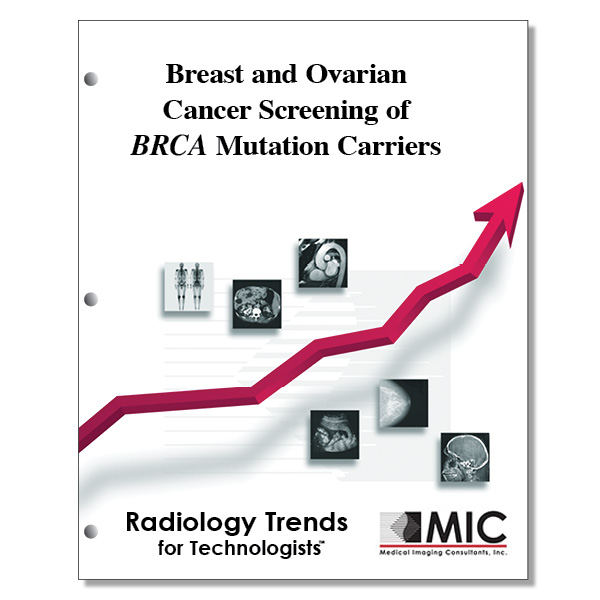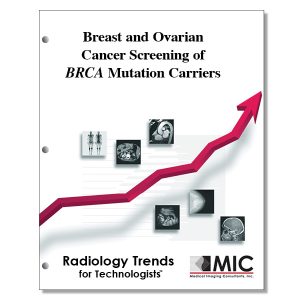

Breast and Ovarian Cancer Screening of BRCA Mutation Carriers
A review of the current screening guidelines for breast and ovarian cancers in patients who test positive for BRCA mutation along with the imaging features that are suspicious for early breast and ovarian cancers.
Course ID: Q00595 Category: Radiology Trends for Technologists Modalities: Mammography, MRI, Radiation Therapy, Sonography3.0 |
Satisfaction Guarantee |
$34.00
- Targeted CE
- Outline
- Objectives
Targeted CE per ARRT’s Discipline, Category, and Subcategory classification for enrollments starting after January 27, 2023:
[Note: Discipline-specific Targeted CE credits may be less than the total Category A credits approved for this course.]
Breast Sonography: 3.00
Patient Care: 2.00
Patient Interactions and Management: 2.00
Procedures: 1.00
Pathology: 0.75
Breast Interventions: 0.25
Computed Tomography: 1.00
Procedures: 1.00
Abdomen and Pelvis: 1.00
Mammography: 3.00
Patient Care: 1.25
Patient Interactions and Management: 1.25
Procedures: 1.75
Anatomy, Physiology, and Pathology: 0.75
Mammographic Positioning, Special Needs, and Imaging Procedures: 1.00
Magnetic Resonance Imaging: 2.00
Procedures: 2.00
Body: 2.00
Registered Radiologist Assistant: 3.00
Procedures: 3.00
Abdominal Section: 1.00
Thoracic Section: 2.00
Sonography: 2.00
Procedures: 2.00
Gynecology: 0.50
Superficial Structures and Other Sonographic Procedures: 1.50
Radiation Therapy: 3.00
Patient Care: 2.00
Patient and Medical Record Management: 2.00
Procedures: 1.00
Treatment Sites and Tumors: 1.00
Outline
- Introduction
- Prevalence of Cancer risk
- Risk Assessment Models
- Guidelines on Genetic Screening and Clinical Management of Patients with BRCA Genetic Mutation
- Breast Cancer
- Histopathology
- Screening tools and Algorithms
- Mammographic Imaging
- Digital Breast Tomosynthesis
- US Screening
- Dynamic Contrast Material-enhanced MRI
- Imaging Requirements for Screening for Breast Cancer
- Imaging Diagnosis of Breast Cancer
- Ovarian Cancer
- Histopathology
- Screening Tools and Algorithms
- Imaging Requirements for Screening for Ovarian Cancer
- Imaging Appearance of Early Ovarian Cancer
- Conclusion
Objectives
Upon completion of this course, students will:
- state the most common cancer in women
- state the 5th most common cancer in women
- describe familial cancer
- compare breast and ovarian cancer rates associated with inheritable genetic mutations
- list the genes associated with the most common genetic mutations implicated in hereditary breast and ovarian cancer
- document the prevalence of the BRCA genetic mutation in the general population
- list the populations most at risk for BRCA founder mutations
- recall the estimated lifetime risk for ovarian cancer in BRCA1 mutation carriers
- list other cancers that BRCA1 and BRCA2 carriers are at increased risk for
- list the requirement of an accurate cancer risk assessment
- state how many cancer prediction models there are available
- know what the CA-125 abbreviation stands for
- interpret table in article to determine criteria for consideration for referral to a cancer genetics specialist
- recall how bilateral prophylactic mastectomy may reduce the incidence of breast cancer in those with BRCA genetic mutation
- list cancer screening options for women with ovarian cancer risks
- summarize the societal and national screening guidelines for breast and ovarian cancers in patients who test positive for BRCA mutation
- state the characteristics of BRCA1-associated breast carcinomas
- define BRCA2-associated breast carcinomas
- state which imaging modality is proven to decrease mortality from breast cancer
- choose the imaging modality that is preferred for screening women with the BRCA mutation over screen-film mammography
- recall the digital breast tomosynthesis detection rate for invasive breast carcinoma
- state the imaging modality used as a supplemental screening tool when there is a contraindication to MR screening for patients who test positive for the BRCA mutation
- identify the imaging modality that is the most sensitive screening modality for BRCA mutation carriers
- state the sensitivity range for MR imaging
- locate table within the article that summarizes the prospective screening trials for breast cancer in patient with an increased risk for breast cancer
- compare the outcomes in the Dutch prospective multicenter MR imaging screening study
- list the outcomes of modeling studies based on data from MRI screening trials
- list the standard mammography screening views
- list the modality that should be used for breast cancer screening in younger patients with dense breast tissue
- state the average scan time for standard full-dynamic contrast-enhanced breast MR imaging protocol
- describe how BRCA-associated breast cancers appear at mammography
- list modalities that should be used when new imaging findings are depicted at screening mammography in BRCA carriers
- state the second most common MR presentation of BRCA-related cancers
- state the precursor lesion to high-grade serous carcinoma
- express at what stage the majority of ovarian cancers are diagnosed
- list the health risks associated with surgically induced early menopause
- state the most widely accepted protocol for ovarian cancer screening in women at high risk
- describe the UK Collaborative Trial in Ovarian Cancer Screening
- list the lesion types of which ultrasound with Doppler examination is excellent at characterizing
- state the imaging modality utilized to evaluate adnexal lesions that are indeterminate at ultrasound
- recall the section thickness for T2-weighted and contrast-enhanced T1-weighted images for ovarian screening
- list what can be done 4-6 hours prior to abdominal MR imaging in order to optimize the examination
- state the survival rate for women with stage 1 ovarian cancer
- state the stage at which most ovarian cancers are diagnosed
- list symptoms that carry a broad differential diagnosis and overlap with symptoms of women with ovarian cancer
